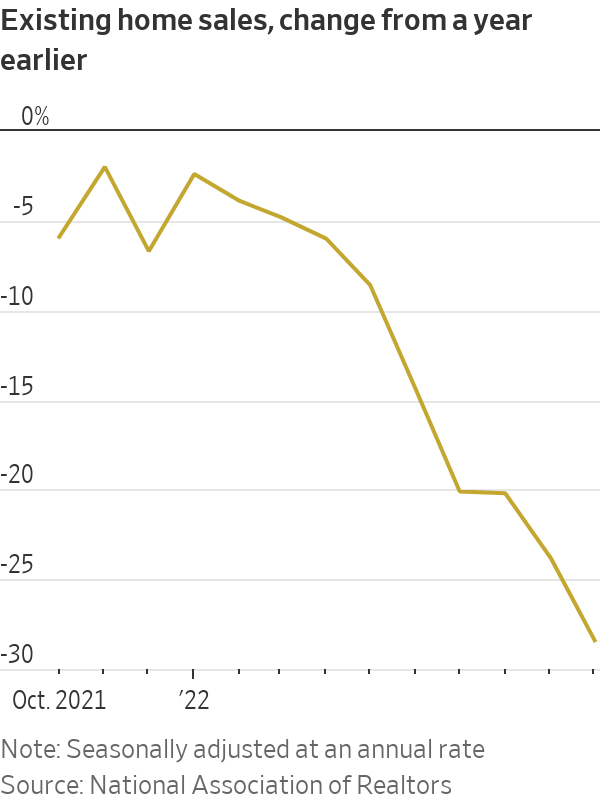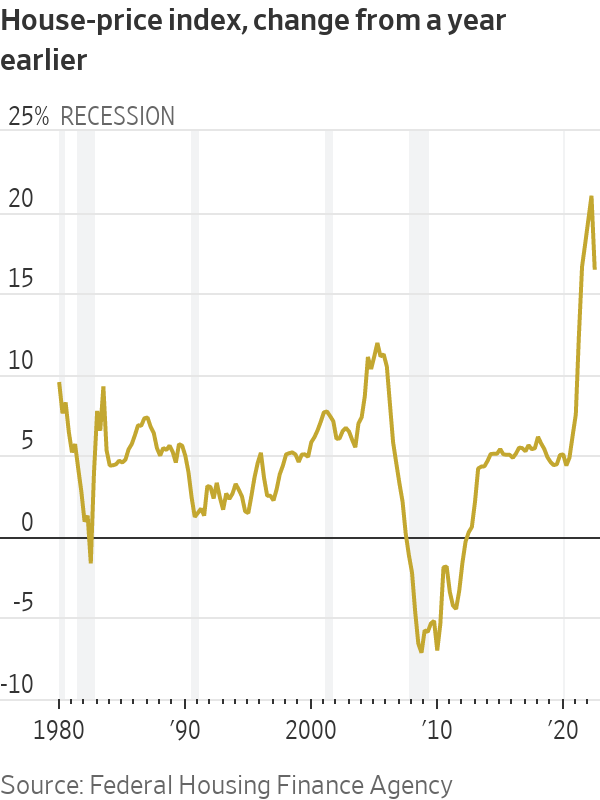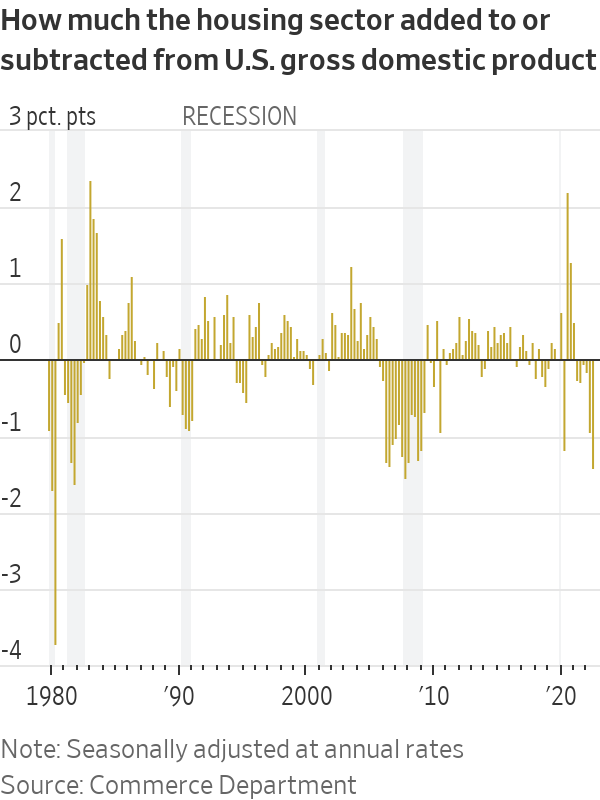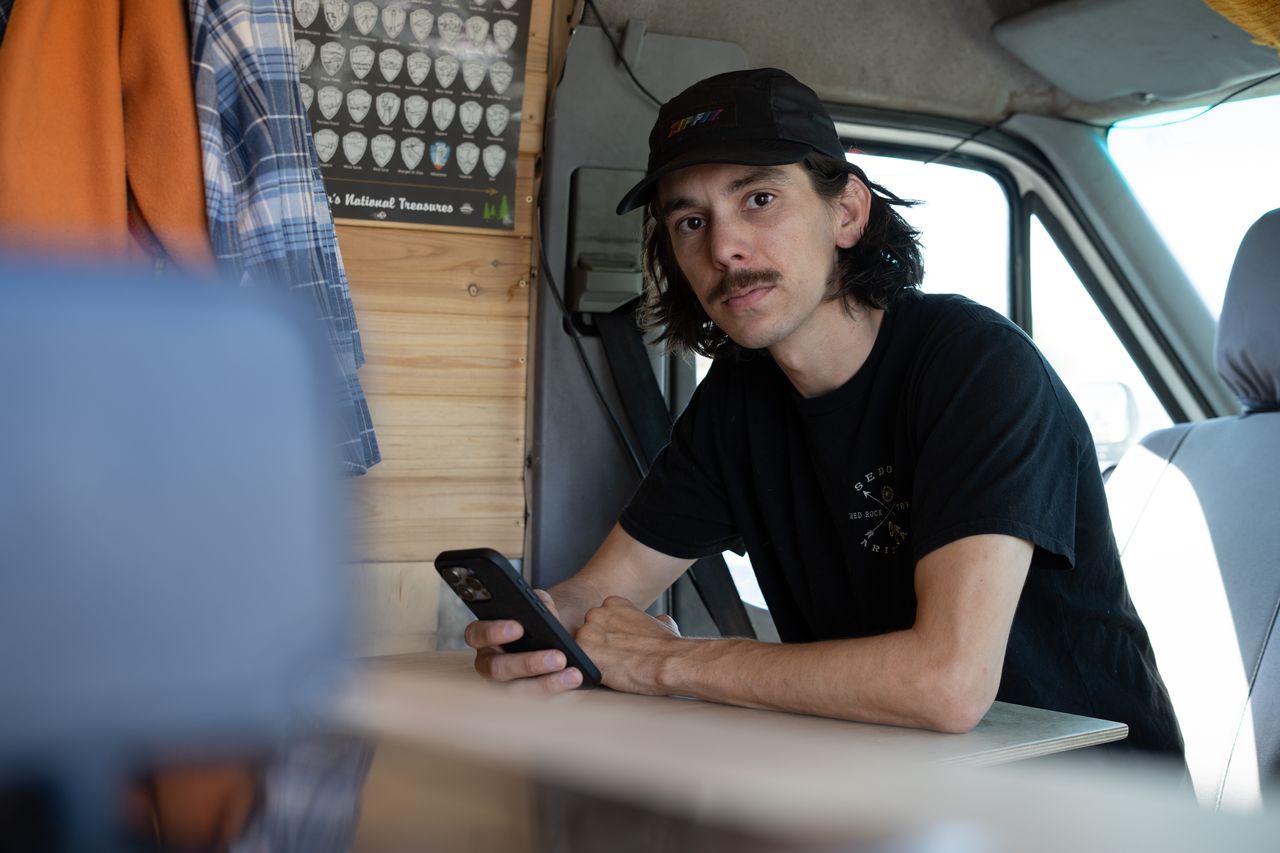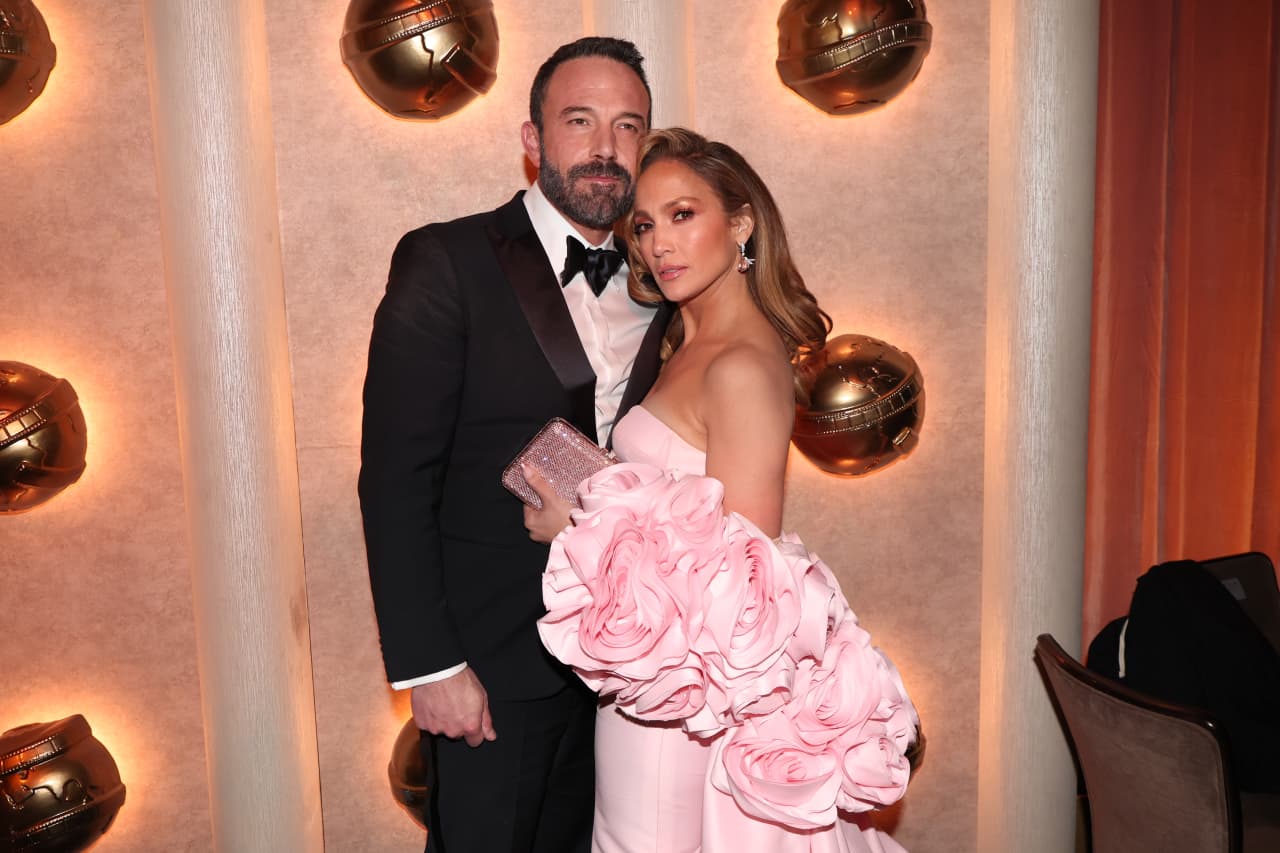What’s Going On With the Housing Market?
Home buyers and sellers are trying to make sense of a downturn that’s full of contradictions: Demand has seized up but supply is still low; prices are sliding but not plummeting; and no one can agree on what comes next
Home sales have plunged. Buyers, facing the fastest-rising mortgage rates in decades, are scrapping their plans. And forecasters have rarely disagreed so much over where the market goes next.
By many measures, the housing market entered a sharp slump this summer after the Federal Reserve abruptly ended a real-estate boom fuelled by the pandemic and record-low borrowing rates.
Mortgage rates climbed above 7% to 20-year highs in October and November before ticking lower in recent weeks. Existing-home sales have dropped for nine straight months through October, the longest streak since the National Association of Realtors began tracking this data in 1999.
It is typical for rising interest rates to cool the housing market. But the speed of this year’s mortgage-rate increase has created a sense of whiplash among buyers and sellers, and that makes it difficult to predict how long the housing slump will last and how bad it will get.
Contradictory signals abound. Demand has tumbled, but the supply of homes is still low. Prices have fallen but are well above their pre-pandemic levels. Interest rates are sky-high compared with a year ago, but below where they stood in the decades when many older Americans bought their first homes.
“When prices are rising, people can’t believe housing will ever go down, and then once prices fall, they can’t believe it will ever go up,” said Glenn Kelman, chief executive at real-estate brokerage Redfin Corp.
The pandemic caused home sales to surge in 2020 and 2021. Home buyers looked for more space with the rise in remote work and rock-bottom interest rates made buying a home affordable for many Americans.
Home prices soared 45% between January 2020 and June 2022, according to the S&P CoreLogic Case-Shiller National Home Price Index. Rents also soared as younger people chose to move out on their own rather than live with roommates.
Federal Reserve Chair Jerome Powell went so far recently as to call the boom phase of the housing market a “bubble.”
“You had housing prices going up at very unsustainable levels and overheating,” he said at a Nov. 30 event. “Now the housing market’s going to go through the other side of that and hopefully come out in a better place.”
Next year’s predictions for home prices are unusually varied, economists say. KPMG LLP, an audit and consulting firm, is calling for prices to fall 20% next year, and Goldman Sachs Group Inc. forecasts a 7.5% drop. The National Association of Realtors, meanwhile, is forecasting a 1.2% increase in existing-home prices, and the Mortgage Bankers Association sees prices up 0.7% next year.
How long the slump in sales lasts depends in part on how long it takes the Fed to get control of inflation, which is running at a 40-year high and has triggered the most rapid series of interest-rate increases by the Fed since the early 1980s. The Fed’s efforts to slow the economy in great part depend on the housing market slumping, both because that cools off demand for goods and services, and because housing itself is an important contributor to inflation. Other factors, such as wage increases, could keep inflation on the boil.
Low supply
The surge in interest rates has pushed both buyers and sellers out of the housing market. Buyers have been priced out, or they have retreated because they think prices might be lower in the future.
Ole and Amanda Wendroth scrapped plans to buy a starter home in Ann Arbor, Mich., earlier this year after being repeatedly outbid. They resumed this fall, and then paused their search again. Even though houses now are sitting on the market longer and prices are starting to fall, interest rates have risen so much that their expected monthly payment would be more than $1,000 beyond what they pay in rent.
“The math just doesn’t add up,” Mr. Wendroth said.
Real-estate agents say unless people have to sell their homes due to life events like job relocations or divorces, they are staying put. Almost 70% of households with mortgages have rates below 4%, and they are reluctant to trade in a low mortgage rate for a higher one on a new home.
Home prices so far haven’t dropped sharply. Prices have slid from their springtime peaks, but they are still above year-ago levels, largely because the supply of homes for sale remains lower than normal for this time of year.
Taylor and Teri Abbett, who have three daughters, looked in 2020 and 2021 for a bigger house to buy in the Pittsburgh area. They lost out on about four offers.
Earlier this year, with interest rates climbing, the Abbetts gave up and decided to stick with their current mortgage, which has an interest rate below 3%, Mr. Abbett said.
“If [home prices] are still inflated and you’re having to pay a higher interest rate, then it’s sort of a no-brainer to step back and see what happens,” he said.
The relatively low inventory is one reason the current plunge in housing activity looks different from the subprime crisis of 2007, which caused years of home-price declines and millions of foreclosures, triggering a global financial crisis that rippled through the rest of the economy.
An impending downturn could look more like the piercing but swift decline in activity recorded in the early 1980s, when the Fed raised rates to double-digits to address very high inflation, said Doug Duncan, chief economist at Fannie Mae.
“People simply stopped transacting,” he said. “As soon as the Fed got control of inflation and started working it down, you saw transactions start to pick up.”
Home prices stopped increasing after the Fed jacked up interest rates in 1979, but prices and sales picked up again in 1983 after the Fed slowed its aggressive rate increases.
Fannie Mae is forecasting that home prices will fall 1.5% next year and 1.4% in 2024.
Others take a more negative view, though most forecasters expect the current housing downturn to be shorter than the prolonged slump following the subprime crisis. Real-estate research and advisory firm Zelman & Associates, a unit of Walker & Dunlop Inc., expects home prices to fall 12% from their peak a few months ago through late 2024, before starting to rebound. John Burns Real Estate Consulting expects prices to fall 20% peak-to-trough and also expects the low point near the end of 2024.
Healthier lending
Homeowners have more equity in their homes than they did ahead of the last downturn, and tighter lending standards since then mean they’re unlikely to default as long as their incomes don’t drop suddenly.
The homeowners most at risk are those who bought homes when prices were near their peak. About 8% of homes bought with mortgages in 2022 were underwater as of September, according to mortgage-data firm Black Knight Inc.
“If you bought at the peak and you put very little money down—yeah, you’re in some trouble,” said Fed governor Christopher Waller at a discussion hosted by UBS in Sydney last month. But for many homeowners who bought in 2020 or earlier, their homes would still be worth far more than they paid, even if prices fell 15%, he said.
Recently, the number of homes for sale has increased as homes sit on the market longer. In the four weeks ended Nov. 27, the number of active listings on the market rose 12.9% from a year earlier, according to Redfin, the real-estate brokerage. But the new listings of homes for sale in that period fell 21% from a year earlier, and supply remains lower than normal.
“What’s stunning is that price declines are occurring without a lot of excess supply,” said Diane Swonk, chief economist at KPMG. “It’s all about affordability.”
Ms. Swonk said she fears that falling home prices could kick off a vicious cycle, particularly if the economy enters a recession and job losses rise. As home values decline, consumers crimp their spending because they feel less wealthy.
While many buyers and sellers are waiting to see where the market will go, home builders need to keep selling homes. Builders increased production in recent years to meet demand, and they have a large backlog of homes still under construction.
About 37% of builders surveyed by the National Association of Home Builders said they cut prices in November, and almost 60% of builders said they used incentives to attract buyers, such as paying lenders to reduce buyers’ mortgage rates.
In the Denver area, real-estate agents are being offered generous commissions and bonuses “from builders who six months ago would not talk to a real-estate broker,” said Lou Barnes, a third-generation mortgage banker in Boulder, Colo.
When home prices start to fall, said Phillippe Lord, chief executive of Scottsdale, Ariz.-based builder Meritage Homes Corp., “buyers are hesitant until they are confident that they’ve sort of reached bottom.”
Mr. Lord said he expects meaningful price declines in some markets, especially in the West. Meritage has cut its prices in some markets, and its cancellation rate rose to 30% in the third quarter, up from 13% the prior quarter.
Some of the housing markets that posted the strongest home-price growth in recent years are leveling off the fastest. In the four weeks ended Nov. 27, pending home sales fell the most year-over-year in Las Vegas; Phoenix; Austin, Texas; Jacksonville, Fla.; and Sacramento, Calif., according to Redfin.
In Sacramento, which became a major destination for people relocating from the Bay Area during the pandemic, median single-family home-sale prices climbed from $400,000 in March 2020 to a peak of $560,000 in June 2022, according to the Sacramento Association of Realtors. By October, the median price had dropped to $510,000.
“We may have further to go, but I just can’t see us going back to the pre-pandemic $400,000,” said Erin Stumpf, who has been a real-estate agent in Sacramento since 2005. “I have a lot of buyers right now that I think are waiting for the first of the year.”
Many prospective buyers can still qualify for loans at current interest rates, but they are afraid to buy when prices are falling and mortgage rates are volatile, said Sheryl Palmer, chief executive of Scottsdale-based builder Taylor Morrison Home Corp.
“Our buyers can afford to buy,” she said. “So much of this is sentiment, and fear, and trying to understand where things are going.”
 Copyright 2020, Dow Jones & Company, Inc. All Rights Reserved Worldwide. LEARN MORE
Copyright 2020, Dow Jones & Company, Inc. All Rights Reserved Worldwide. LEARN MORE
This stylish family home combines a classic palette and finishes with a flexible floorplan
Just 55 minutes from Sydney, make this your creative getaway located in the majestic Hawkesbury region.
Ahead of the Games, a breakdown of the city’s most desirable places to live
PARIS —Paris has long been a byword for luxurious living. The traditional components of the upscale home, from parquet floors to elaborate moldings, have their origins here. Yet settling down in just the right address in this low-rise, high-density city may be the greatest luxury of all.
Tradition reigns supreme in Paris real estate, where certain conditions seem set in stone—the western half of the city, on either side of the Seine, has long been more expensive than the east. But in the fashion world’s capital, parts of the housing market are also subject to shifting fads. In the trendy, hilly northeast, a roving cool factor can send prices in this year’s hip neighborhood rising, while last year’s might seem like a sudden bargain.
This week, with the opening of the Olympic Games and the eyes of the world turned toward Paris, The Wall Street Journal looks at the most expensive and desirable areas in the City of Light.
The Most Expensive Arrondissement: the 6th
Known for historic architecture, elegant apartment houses and bohemian street cred, the 6th Arrondissement is Paris’s answer to Manhattan’s West Village. Like its New York counterpart, the 6th’s starving-artist days are long behind it. But the charm that first wooed notable residents like Gertrude Stein and Jean-Paul Sartre is still largely intact, attracting high-minded tourists and deep-pocketed homeowners who can afford its once-edgy, now serene atmosphere.
Le Breton George V Notaires, a Paris notary with an international clientele, says the 6th consistently holds the title of most expensive arrondissement among Paris’s 20 administrative districts, and 2023 was no exception. Last year, average home prices reached $1,428 a square foot—almost 30% higher than the Paris average of $1,100 a square foot.
According to Meilleurs Agents, the Paris real estate appraisal company, the 6th is also home to three of the city’s five most expensive streets. Rue de Furstemberg, a secluded loop between Boulevard Saint-Germain and the Seine, comes in on top, with average prices of $2,454 a square foot as of March 2024.
For more than two decades, Kyle Branum, a 51-year-old attorney, and Kimberly Branum, a 60-year-old retired CEO, have been regular visitors to Paris, opting for apartment rentals and ultimately an ownership interest in an apartment in the city’s 7th Arrondissement, a sedate Left Bank district known for its discreet atmosphere and plutocratic residents.
“The 7th was the only place we stayed,” says Kimberly, “but we spent most of our time in the 6th.”
In 2022, inspired by the strength of the dollar, the Branums decided to fulfil a longstanding dream of buying in Paris. Working with Paris Property Group, they opted for a 1,465-square-foot, three-bedroom in a building dating to the 17th century on a side street in the 6th Arrondissement. They paid $2.7 million for the unit and then spent just over $1 million on the renovation, working with Franco-American visual artist Monte Laster, who also does interiors.
The couple, who live in Santa Barbara, Calif., plan to spend about three months a year in Paris, hosting children and grandchildren, and cooking after forays to local food markets. Their new kitchen, which includes a French stove from luxury appliance brand Lacanche, is Kimberly’s favourite room, she says.
Another American, investor Ashley Maddox, 49, is also considering relocating.
In 2012, the longtime Paris resident bought a dingy, overstuffed 1,765-square-foot apartment in the 6th and started from scratch. She paid $2.5 million and undertook a gut renovation and building improvements for about $800,000. A centrepiece of the home now is the one-time salon, which was turned into an open-plan kitchen and dining area where Maddox and her three children tend to hang out, American-style. Just outside her door are some of the city’s best-known bakeries and cheesemongers, and she is a short walk from the Jardin du Luxembourg, the Left Bank’s premier green space.
“A lot of the majesty of the city is accessible from here,” she says. “It’s so central, it’s bananas.” Now that two of her children are going away to school, she has listed the four-bedroom apartment with Varenne for $5 million.
The Most Expensive Neighbourhoods: Notre-Dame and Invalides
Garrow Kedigian is moving up in the world of Parisian real estate by heading south of the Seine.
During the pandemic, the Canada-born, New York-based interior designer reassessed his life, he says, and decided “I’m not going to wait any longer to have a pied-à-terre in Paris.”
He originally selected a 1,130-square-foot one-bedroom in the trendy 9th Arrondissement, an up-and-coming Right Bank district just below Montmartre. But he soon realised it was too small for his extended stays, not to mention hosting guests from out of town.
After paying about $1.6 million in 2022 and then investing about $55,000 in new decor, he put the unit up for sale in early 2024 and went house-shopping a second time. He ended up in the Invalides quarter of the 7th Arrondissement in the shadow of one Paris’s signature monuments, the golden-domed Hôtel des Invalides, which dates to the 17th century and is fronted by a grand esplanade.
His new neighbourhood vies for Paris’s most expensive with the Notre-Dame quarter in the 4th Arrondissement, centred on a few islands in the Seine behind its namesake cathedral. According to Le Breton, home prices in the Notre-Dame neighbourhood were $1,818 a square foot in 2023, followed by $1,568 a square foot in Invalides.
After breaking even on his Right Bank one-bedroom, Kedigian paid $2.4 million for his new 1,450-square-foot two-bedroom in a late 19th-century building. It has southern exposures, rounded living-room windows and “gorgeous floors,” he says. Kedigian, who bought the new flat through Junot Fine Properties/Knight Frank, plans to spend up to $435,000 on a renovation that will involve restoring the original 12-foot ceiling height in many of the rooms, as well as rescuing the ceilings’ elaborate stucco detailing. He expects to finish in 2025.
Over in the Notre-Dame neighbourhood, Belles demeures de France/Christie’s recently sold a 2,370-square-foot, four-bedroom home for close to the asking price of about $8.6 million, or about $3,630 a square foot. Listing agent Marie-Hélène Lundgreen says this places the unit near the very top of Paris luxury real estate, where prime homes typically sell between $2,530 and $4,040 a square foot.
The Most Expensive Suburb: Neuilly-sur-Seine
The Boulevard Périphérique, the 22-mile ring road that surrounds Paris and its 20 arrondissements, was once a line in the sand for Parisians, who regarded the French capital’s numerous suburbs as something to drive through on their way to and from vacation. The past few decades have seen waves of gentrification beyond the city’s borders, upgrading humble or industrial districts to the north and east into prime residential areas. And it has turned Neuilly-sur-Seine, just northwest of the city, into a luxury compound of first resort.
In 2023, Neuilly’s average home price of $1,092 a square foot made the leafy, stately community Paris’s most expensive suburb.
Longtime residents, Alain and Michèle Bigio, decided this year is the right time to list their 7,730-square-foot, four-bedroom townhouse on a gated Neuilly street.
The couple, now in their mid 70s, completed the home in 1990, two years after they purchased a small parcel of garden from the owners next door for an undisclosed amount. Having relocated from a white-marble château outside Paris, the couple echoed their previous home by using white- and cream-coloured stone in the new four-story build. The Bigios, who will relocate just back over the border in the 16th Arrondissement, have listed the property with Emile Garcin Propriétés for $14.7 million.
The couple raised two adult children here and undertook upgrades in their empty-nester years—most recently, an indoor pool in the basement and a new elevator.
The cool, pale interiors give way to dark and sardonic images in the former staff’s quarters in the basement where Alain works on his hobby—surreal and satirical paintings, whose risqué content means that his wife prefers they stay downstairs. “I’m not a painter,” he says. “But I paint.”
The Trendiest Arrondissement: the 9th
French interior designer Julie Hamon is theatre royalty. Her grandfather was playwright Jean Anouilh, a giant of 20th-century French literature, and her sister is actress Gwendoline Hamon. The 52-year-old, who divides her time between Paris and the U.K., still remembers when the city’s 9th Arrondissement, where she and her husband bought their 1,885-square-foot duplex in 2017, was a place to have fun rather than put down roots. Now, the 9th is the place to do both.
The 9th, a largely 19th-century district, is Paris at its most urban. But what it lacks in parks and other green spaces, it makes up with nightlife and a bustling street life. Among Paris’s gentrifying districts, which have been transformed since 2000 from near-slums to the brink of luxury, the 9th has emerged as the clear winner. According to Le Breton, average 2023 home prices here were $1,062 a square foot, while its nearest competitors for the cool crown, the 10th and the 11th, have yet to break $1,011 a square foot.
A co-principal in the Bobo Design Studio, Hamon—whose gut renovation includes a dramatic skylight, a home cinema and air conditioning—still seems surprised at how far her arrondissement has come. “The 9th used to be well known for all the theatres, nightclubs and strip clubs,” she says. “But it was never a place where you wanted to live—now it’s the place to be.”
With their youngest child about to go to college, she and her husband, 52-year-old entrepreneur Guillaume Clignet, decided to list their Paris home for $3.45 million and live in London full-time. Propriétés Parisiennes/Sotheby’s is handling the listing, which has just gone into contract after about six months on the market.
The 9th’s music venues were a draw for 44-year-old American musician and piano dealer, Ronen Segev, who divides his time between Miami and a 1,725-square-foot, two-bedroom in the lower reaches of the arrondissement. Aided by Paris Property Group, Segev purchased the apartment at auction during the pandemic, sight unseen, for $1.69 million. He spent $270,000 on a renovation, knocking down a wall to make a larger salon suitable for home concerts.
During the Olympics, Segev is renting out the space for about $22,850 a week to attendees of the Games. Otherwise, he prefers longer-term sublets to visiting musicians for $32,700 a month.
Most Exclusive Address: Avenue Junot
Hidden in the hilly expanses of the 18th Arrondissement lies a legendary street that, for those in the know, is the city’s most exclusive address. Avenue Junot, a bucolic tree-lined lane, is a fairy-tale version of the city, separate from the gritty bustle that surrounds it.
Homes here rarely come up for sale, and, when they do, they tend to be off-market, or sold before they can be listed. Martine Kuperfis—whose Paris-based Junot Group real-estate company is named for the street—says the most expensive units here are penthouses with views over the whole of the city.
In 2021, her agency sold a 3,230-square-foot triplex apartment, with a 1,400-square-foot terrace, for $8.5 million. At about $2,630 a square foot, that is three times the current average price in the whole of the 18th.
Among its current Junot listings is a 1930s 1,220-square-foot townhouse on the avenue’s cobblestone extension, with an asking price of $2.8 million.
This stylish family home combines a classic palette and finishes with a flexible floorplan
Just 55 minutes from Sydney, make this your creative getaway located in the majestic Hawkesbury region.










